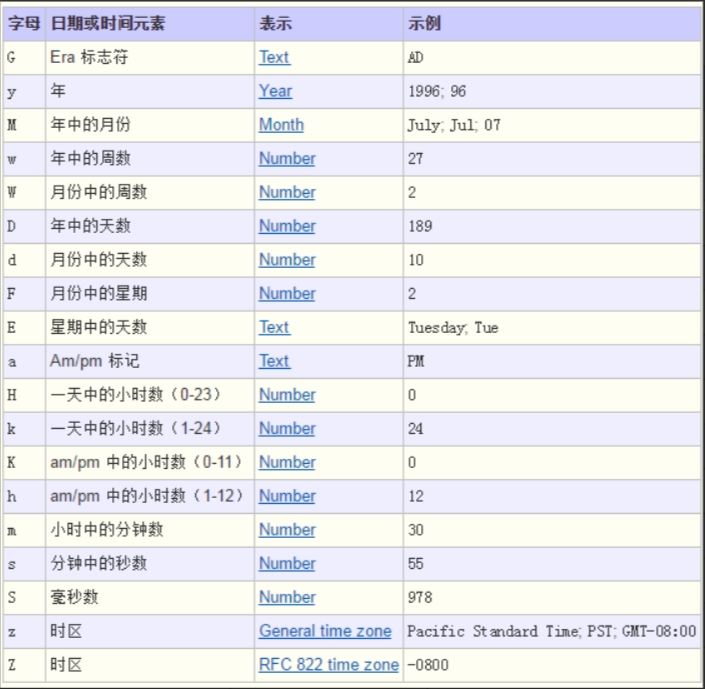字母 | 释义 |
yyyy | 年 |
MM | 月 |
dd | 日 |
hh | 1~12小时制(1-12) |
HH | 24小时制(0-23) |
mm | 分 |
ss | 秒 |
S | 毫秒 |
E | 星期几 |
D | 一年中的第几天 |
F | 一月中的第几个星期(会把这个月总共过的天数除以7) |
w | 一年中的第几个星期 |
W | 一月中的第几星期(会根据实际情况来算) |
a | 上下午标识 |
k | 和HH差不多,表示一天24小时制(1-24)。 |
K | 和hh差不多,表示一天12小时制(0-11)。 |
z | 表示时区 |
上面的日期和时间模式 是按我们常用的年月日时分秒来放的,下面是专业的图,供参考。
定义了以下模式字母(所有其他字符 'A' 到 'Z' 和 'a' 到 'z' 都被保留)

/**
* java.util.Date转String
* 年-月-日 上/下午标识 时:分:秒.毫秒 星期几 时区英文时区数字
* @param d
* @return
*/
public static String DateToString(Date d) {
//年-月-日 上/下午标识 时:分:秒.毫秒 星期几 时区英文时区数字
SimpleDateFormat sdf = new SimpleDateFormat("yyyy-MM-dd a HH:mm:ss.SSS E zZ");
return sdf.format(d);
}
/**
* String转java.util.Date
* 年-月-日 上/下午标识 时:分:秒.毫秒 星期几 时区英文时区数字
* @param d
* @return
*/
public static Date StringToDate(String str) {
//年-月-日 上/下午标识 时:分:秒.毫秒 星期几 时区英文时区数字
SimpleDateFormat sdf = new SimpleDateFormat("yyyy-MM-dd a HH:mm:ss.SSS E zZ");
Date date = null;
try {
date = sdf.parse(str);
} catch (ParseException e) {
// TODO 自动生成的 catch 块
e.printStackTrace();
}
return date;
}
/**
* 输入一个人的身份证号码,输出出身年月日,格式为xx年xx月xx日并求年龄
* @param idCard 身份证号码
* @return 格式为xx年xx月xx日并求年龄
*/
public static String getDateAndAgeByIdCard(String idCard) {
String str = "";
try {
// 第一种输出年月日
String b = idCard.substring(6, 14);
// 日期对象 要与最开始的日期格式一致不能加年月日
SimpleDateFormat sdf = new SimpleDateFormat("yyyyMMdd");
// 将字符串转为日期对象 转为日期对象后就可以改变自己想要的格式了(就是sdf1定义)
Date dt = sdf.parse(b);
// 定义自己想要的日期格式,转化为日期对象后定义自己想要的格式
SimpleDateFormat sdf1 = new SimpleDateFormat("yyyy年MM月dd日");
String f = sdf1.format(dt);// 格式化日期对象
// 求年龄
Date now = new Date();
// getTime()是指自己距离1970年为止的毫秒数
// 转为 秒 /分/时/日/年
long age = (now.getTime() - dt.getTime()) / 1000 / 60 / 60 / 24 / 360;
str = "出生日期: " + f + ",年龄: " + age + "岁";
} catch (Exception e) {
// TODO: handle exception
e.printStackTrace();
}
return str;
}
由于 SimpleDateFormat 中的 format 方法在执行过程中,会使用一个成员变量 calendar 来保存时间。
private StringBuffer format(Date date, StringBuffer toAppendTo, FieldDelegate delegate) {
this.calendar.setTime(date);
boolean useDateFormatSymbols = this.useDateFormatSymbols();
int i = 0;
……
由于在声明 SimpleDateFormat 的时候,使用的是 static 定义的。那么这个 SimpleDateFormat 就是一个共享变量,SimpleDateFormat 中的 calendar 也就可以被多个线程访问到。
举个例子:假设一个线程 A 刚执行完 calendar.setTime 把时间设置成 2020-05-07,这个线程还没执行完,线程 B 又执行了 calendar.setTime 把时间改成了 2020-06-07。这时候线程 A 继续往下执行,拿到的 calendar.getTime 得到的时间就是线程 B 改过之后的。
除了 format 方法以外,SimpleDateFormat 的 parse 方法也有同样的问题。
所以,不要把 SimpleDateFormat 作为一个共享变量使用。
如果使用的是Java 8 之前的JDK,可以使 SimpleDateFormat 变成线程安全的,通过加锁的方式来解决:
/**
* 线程安全的 SimpleDateFormat
*/
private static ThreadLocal<DateFormat> threadLocal = new ThreadLocal<DateFormat>();
/**
* 获取 DateFormat
* @param pattern 格式化
* @return DateFormat
*/
public static DateFormat getDateFormat(String pattern) {
DateFormat df = threadLocal.get();
if(df == null){
df = new SimpleDateFormat(pattern);
threadLocal.set(df);
}
return df;
}
如果使用的是Java 8 + 的版本,那么完全可以抛弃这种线程不安全的时间格式化方法。可以使用 DateTimeFormatter 代替 SimpleDateFormat,这是一个线程安全的格式化工具类。
package com;
import java.text.DateFormat;
import java.text.DecimalFormat;
import java.text.ParseException;
import java.text.SimpleDateFormat;
import java.util.Date;
public class SimpleDateFormatSimple {
/**
* 线程安全的 SimpleDateFormat
*/
private static ThreadLocal<DateFormat> threadLocal = new ThreadLocal<DateFormat>();
/**
* 获取 DateFormat
* @param pattern 格式化
* @return DateFormat
*/
public static DateFormat getDateFormat(String pattern) {
DateFormat df = threadLocal.get();
if(df == null){
df = new SimpleDateFormat(pattern);
threadLocal.set(df);
}
return df;
}
/**
* java.util.Date转String
* 年-月-日 上/下午标识 时:分:秒.毫秒 星期几 时区英文时区数字
* @param d
* @return
*/
public static String DateToStringByThreadLocal(Date d) {
return getDateFormat("yyyy-MM-dd a HH:mm:ss.SSS E zZ").format(d);
}
/**
* java.util.Date转String
* 年-月-日 上/下午标识 时:分:秒.毫秒 星期几 时区英文时区数字
* @param d
* @return
*/
public static String DateToString(Date d) {
//年-月-日 上/下午标识 时:分:秒.毫秒 星期几 时区英文时区数字
SimpleDateFormat sdf = new SimpleDateFormat("yyyy-MM-dd a HH:mm:ss.SSS E zZ");
return sdf.format(d);
}
/**
* String转java.util.Date
* 年-月-日 上/下午标识 时:分:秒.毫秒 星期几 时区英文时区数字
* @param d
* @return
*/
public static Date StringToDate(String str) {
//年-月-日 上/下午标识 时:分:秒.毫秒 星期几 时区英文时区数字
SimpleDateFormat sdf = new SimpleDateFormat("yyyy-MM-dd a HH:mm:ss.SSS E zZ");
Date date = null;
try {
date = sdf.parse(str);
} catch (ParseException e) {
// TODO 自动生成的 catch 块
e.printStackTrace();
}
return date;
}
/**
* 输入一个人的身份证号码,输出出身年月日,格式为xx年xx月xx日并求年龄
* @param idCard 身份证号码
* @return 格式为xx年xx月xx日并求年龄
*/
public static String getDateAndAgeByIdCard(String idCard) {
String str = "";
try {
// 第一种输出年月日
String b = idCard.substring(6, 14);
// 日期对象 要与最开始的日期格式一致不能加年月日
SimpleDateFormat sdf = new SimpleDateFormat("yyyyMMdd");
// 将字符串转为日期对象 转为日期对象后就可以改变自己想要的格式了(就是sdf1定义)
Date dt = sdf.parse(b);
// 定义自己想要的日期格式,转化为日期对象后定义自己想要的格式
SimpleDateFormat sdf1 = new SimpleDateFormat("yyyy年MM月dd日");
String f = sdf1.format(dt);// 格式化日期对象
// 求年龄
Date now = new Date();
// getTime()是指自己距离1970年为止的毫秒数
// 转为 秒 /分/时/日/年
long age = (now.getTime() - dt.getTime()) / 1000 / 60 / 60 / 24 / 360;
str = "出生日期: " + f + ",年龄: " + age + "岁";
} catch (Exception e) {
// TODO: handle exception
e.printStackTrace();
}
return str;
}
}